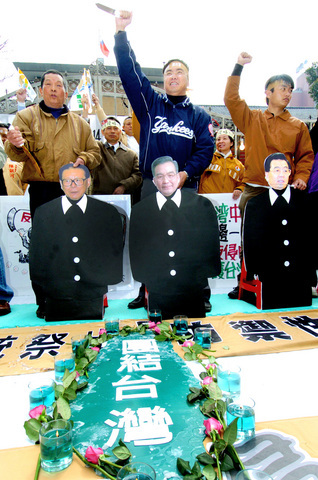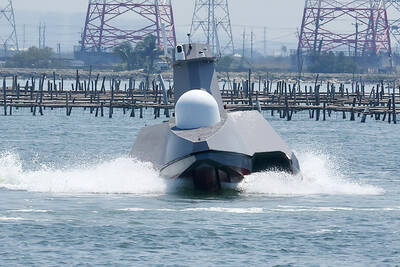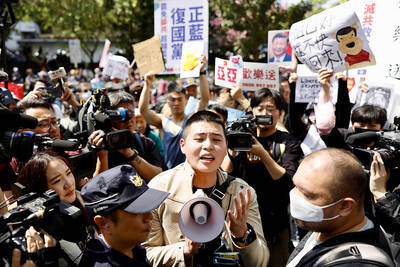The US hit out at China's newly-adopted "anti-secession" law Monday, describing it as an "unfortunate" and "unhelpful" action that could increase tensions.
The legislation, adopted earlier in the day by China's rubber-stamp National People's Congress, "does not serve the purpose of peace and stability in the Taiwan Strait," said White House press secretary Scott McClellan.
Responding to the law's authorizing the use of "non-peaceful means" against Taiwan, McClellan said: "We oppose any attempts to determine the future of Taiwan by anything other than peaceful means."

PHOTO: GEORGE TSORNG, TAIPEI TIMES
"We don't want to see any unilateral attempts that would increase tensions in this region. So this is not helpful," he said.
McClellan also repeated that the administration does not support Taiwan's independence.
The anti-secession law is certain to come up during Secretary of State Condoleezza Rice's trip to Asia this week, which will include a stop in Beijing later in the week.
"We will be, I am sure, talking about Taiwan during the course of the trip," State Department spokesman Richard Boucher said.
"Our view remains that they need to move in the direction of peaceful dialogue. She will encourage them to do that, and look forward to hearing from them as to how they might be willing to move in that direction," and what they might be willing to do, he said.
On the eve of her trip, Rice criticized the law, saying "it raises tensions, and it's not necessary or a good thing to raise tensions."
In an interview on Sunday morning television, Rice described the US as "an upright anchor in this dispute for a long time."
"The key is that there should be no effort on either side to unilaterally change the status quo," she said, adding that it is "far too early to make conclusions" about whether the law invalidates the long-standing assumption that as China becomes more prosperous, it will become more peaceful.
Meanwhile, the Republican congressional leadership apparently is still resisting pressure to pass a resolution condemning the anti-secession law. An agenda for this week's floor activity in the House, where such resolutions usually get their first airing, contains no provision for debating or voting on either of two resolutions introduced by House members last month urging the Bush administration to strongly oppose the anti-secession law.
As the administration voiced its concerns over the new Chinese law Monday, the State Department also cautioned the Chen administration from taking potentially incendiary countermeasures.
"We have urged both sides to avoid any steps that raise tensions. We have encouraged both sides to avoid any steps to try to define unilaterally some kind of solution to their differences," Boucher said.
But he declined to answer directly a question about the planned March 26 demonstrations against the law or any other action Chen might take.
"I don't have any particular view of a demonstration or a counter-reaction, as hypothetical as it is right now," he said.
"The issues between Taiwan and [China] need to be solved in dialogue. Neither side is going to get anywhere with unilateral steps," he reiterated.
Boucher could not say whether the passage of the law will have an impact on US efforts to convince the EU not to go through with its plans to lift its arms embargo on China.
But he said that the prospect of a Chinese attack on Taiwan "should be disserving to the Europeans as it is to us."

ENDEAVOR MANTA: The ship is programmed to automatically return to its designated home port and would self-destruct if seized by another party The Endeavor Manta, Taiwan’s first military-specification uncrewed surface vehicle (USV) tailor-made to operate in the Taiwan Strait in a bid to bolster the nation’s asymmetric combat capabilities made its first appearance at Kaohsiung’s Singda Harbor yesterday. Taking inspiration from Ukraine’s navy, which is using USVs to force Russia’s Black Sea fleet to take shelter within its own ports, CSBC Taiwan (台灣國際造船) established a research and development unit on USVs last year, CSBC chairman Huang Cheng-hung (黃正弘) said. With the exception of the satellite guidance system and the outboard motors — which were purchased from foreign companies that were not affiliated with Chinese-funded

PERMIT REVOKED: The influencer at a news conference said the National Immigration Agency was infringing on human rights and persecuting Chinese spouses Chinese influencer “Yaya in Taiwan” (亞亞在台灣) yesterday evening voluntarily left Taiwan, despite saying yesterday morning that she had “no intention” of leaving after her residence permit was revoked over her comments on Taiwan being “unified” with China by military force. The Ministry of the Interior yesterday had said that it could forcibly deport the influencer at midnight, but was considering taking a more flexible approach and beginning procedures this morning. The influencer, whose given name is Liu Zhenya (劉振亞), departed on a 8:45pm flight from Taipei International Airport (Songshan airport) to Fuzhou, China. Liu held a news conference at the airport at 7pm,

AIR SUPPORT: The Ministry of National Defense thanked the US for the delivery, adding that it was an indicator of the White House’s commitment to the Taiwan Relations Act Deputy Minister of National Defense Po Horng-huei (柏鴻輝) and Representative to the US Alexander Yui on Friday attended a delivery ceremony for the first of Taiwan’s long-awaited 66 F-16C/D Block 70 jets at a Lockheed Martin Corp factory in Greenville, South Carolina. “We are so proud to be the global home of the F-16 and to support Taiwan’s air defense capabilities,” US Representative William Timmons wrote on X, alongside a photograph of Taiwanese and US officials at the event. The F-16C/D Block 70 jets Taiwan ordered have the same capabilities as aircraft that had been upgraded to F-16Vs. The batch of Lockheed Martin

GRIDLOCK: The National Fire Agency’s Special Search and Rescue team is on standby to travel to the countries to help out with the rescue effort A powerful earthquake rocked Myanmar and neighboring Thailand yesterday, killing at least three people in Bangkok and burying dozens when a high-rise building under construction collapsed. Footage shared on social media from Myanmar’s second-largest city showed widespread destruction, raising fears that many were trapped under the rubble or killed. The magnitude 7.7 earthquake, with an epicenter near Mandalay in Myanmar, struck at midday and was followed by a strong magnitude 6.4 aftershock. The extent of death, injury and destruction — especially in Myanmar, which is embroiled in a civil war and where information is tightly controlled at the best of times —